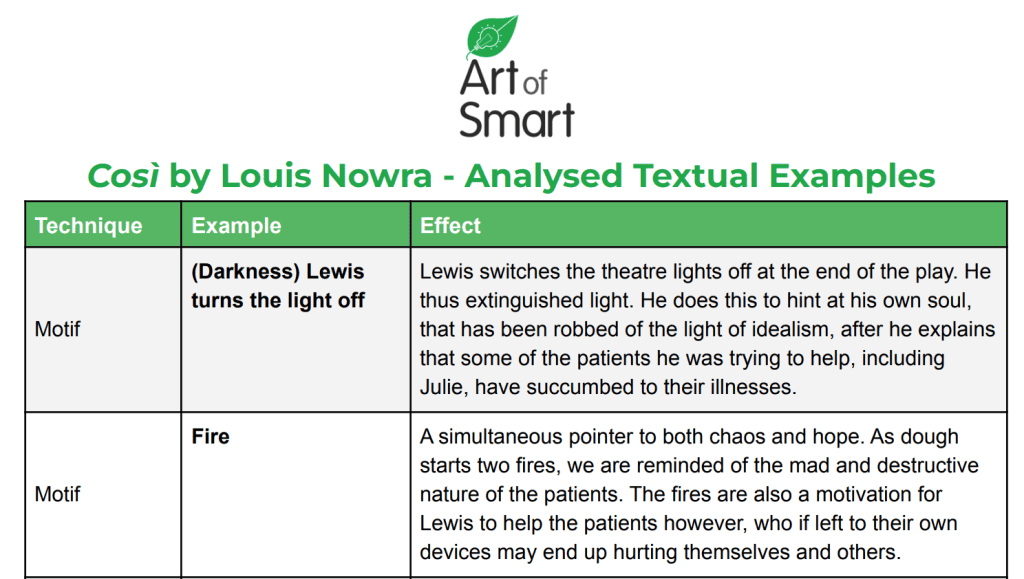Focussing on the play, ‘Cosi’, by Louis Nowra for English but have no idea where to start with your essay analysis?
Don’t stress! We’ve got you covered with our in-depth guide on the play, diving into a summary of Cosi, the key characters, context, themes and more.
We’ll even give you access to our sample analysis table (also called a TEE table) and an example of a paragraph that gets high marks for Cosi!
Ready to get started? Let’s go!
‘Cosi’ by Louis Nowra Play Summary
Key Characters in Cosi
Context
Themes Explored in Cosi
Play Analysis of Cosi by Louis Nowra
Play Summary of Cosi by Louis Nowra
The play opens with three main characters meeting each other in what remains of a run-down, destitute theatre. Lewis and his girlfriend Lucy, as well as their friend Nick, are greeted out of the blue by a mentally ill man, Roy, as they try and fail to turn on the lights.
The caretaker of the man, Lewis (for the purposes of explanation, we’ll call him “Lewis 2” to avoid confusion) also greets the three friends. The play revolves around a group of mentally ill people, as well as a group of ‘normal’ people, and the perceptions between them.
Lewis 2 is introduced to audiences as an extremely caring and compassionate person, who makes sure to highlight to the three friends that mentally ill patients are to be seen as human beings too. The three friends begin to set up a play, assisted by the mentally ill patients, as suggested by Lewis 2.
Other mentally ill patients are introduced here — three men and three women. The men are Henry, Zac and Dough, although the latter is the most significant, as he was sent to the asylum for having set his mother’s cat on fire.
The three women are Julie, Cherry and Ruth, with substance addiction, uncontrolled violence and obsessive-compulsive behaviour issues respectively.
Roy suggests they try to perform the opera ‘Così Fan Tutte’ (literally “like this is everyone”) despite Lewis having doubts about the success.
The opera is about two men that test the fidelity of their wives by dressing up as Albanian Soldiers and propose. The women agree, and the two men eventually show their true identities.
Next, the atmosphere of calm and disinterest in the play are shattered when a fire is discovered in an underground passage in the theatre. Cherry tries to strangle Dough, who discovered the fire, while Zac collapses. Despite Lewis trying to pull everyone together, the audience and Lewis realise that the patients remain unpredictable.
Lewis and Julie exchange stories, and Julie finds out that Lucy is more preoccupied with the controversial Vietnam War than with her relationship with Lewis. It’s here that, after Dough is admitted to a closed ward for starting another fire, Nick accuses Lewis of spending too much time trying to make the play work instead of focussing on the Vietnam War, which both Nick and Lucy are more interested about.
Lewis and Julie share a kiss as they get closer to each other on an emotional level, while the other patients improve in terms of behaviour due to their involvement in the play. This is a positive step for Lewis, who refuses to go to an anti-war march with Lucy and stays with the patients.
Inevitably, Lucy and Lewis have a fight, as Lucy learns that he shared a kiss with Julie. Nevertheless, Lewis also learns of an affair between Nick and Lucy since he started working on the play, events that follow the plot of the opera to the letter, ironically.
Not sure which techniques are best for analysing plays? Check out our ‘Photograph 51’ analysis here!
This escalates to the opening night, where Nick confronts Lewis. Lewis however decides to be immovable, and punches Nick, severing their bond indefinitely. Lewis takes on the worries of his actors, and delivers the play.
Patients explain the benefits of participating in the play. Lewis, however, is the one that has most benefited, abandoning his idealism and embracing compassion along the road.
The most tragic of the endings is that Julie is said to have passed away from an overdose after leaving the institute.
Key Characters in Cosi
Lewis
Lewis is the narrator of the story. This fact is significant, as we get a wider perspective into what he is all about in terms of his idealism. Lewis starts out just wanting to help people, a significant reason why activism about the Vietnam war is something he is involved with.
Nevertheless, he develops, realising the often cruel outcomes of life. It happens as part of his work with the mentally ill patients, his disillusionment with his girlfriend, and his arguments with Nick.
After seeing the results he has with his theatre production, he realises the power he has from helping people get better in terms of their mental and physical health. When his friends try and prevent him from succeeding, he chooses this over them.
Nick
As passionate as Lucy about the injustice of the Vietnam War, Nick sees Lewis as his best friend initially. The key difference between Nick and Lewis is that Nick does not see the patients as equal human beings to him.
Therefore he puts what Lewis is doing on a second plane, unequal to the one that he and Lucy operate on. This is why an affair starts to develop between the two, and why Nick ultimately breaks his friendship with Lewis.
It was inevitable due to differences in how both see the world.
Lucy
Lucy mirrors Nick in that she is unable to see the importance of helping those closest to her. She could have had greater impact with those immediately around her, rather than focussing on those farthest from her.
This key difference is one that puts Lewis and Lucy into full contention, and results in their breakup. Neither Lucy or Nick can be considered bad people, yet they are ‘blind’ in a sense, but instrumental in helping Lewis grow out of his idealism.
Julie
Her fate helps Lewis overcome his idealism of a life with a happy ending. Her eventual death by overdose is a cruel fact of life that the protagonist has to accept, despite him trying his best at helping her.
Yet Julie is also a testimony that ‘sick’ people are no different than ‘normal’ human beings, and are capable of having a ‘normal’ life. While with Lewis, Julie begins to recover from her addiction, and even starts a romance with the protagonist.
Dough
His character conveys the erratic nature that may occur with mental illness and instability, and serves as a reminder of reality for Lewis.
Dough starts two fires, that end up almost ruining the synergy Lewis has with the other patients. Therefore he is instrumental in the sense that he keeps Lewis grounded.
Context
The play draws heavily on the context of the Vietnam War, and the social climate during those years. This is especially important due to the direct interest in this factor by some of the main characters.
Both Lucy and Nick easily embody the public outrage and resistance typical of those years, where individuals were protesting against the war, and more importantly, against the participation in it, that cost thousands of young lives by the end.
Such events practically overshadowed other social problems and marginalised groups, such as those who were mentally ill. This is conveyed in the play.
We see that Lewis, unlike his friends, consider the mentally ill’s plight on par with, if not more important than, the central issue of the time. Failure to understand this ultimately creates the central dramatic tension and resolution of the story.
Themes Explored in Cosi by Louis Nowra
Loyalty
There are three main aspects that point to this theme. One of them is the direct allusion to the opera “Così fan tutte”, which as explained before, explores fidelity in relationships, loyalty to one another, and the widespread fact that this is often rare and somewhat hard to ask for in reality.
Another aspect that screams ‘loyalty’ is the relationship between the protagonist and his friends. Lucy ends up betraying Lewis for Nick, and Lewis ends up falling for Julie.
Again, this dynamic points back to the unrealistic fairytale of fidelity and love that lasts forever, that is explored in both this play and the opera it tries to represent.
Lastly, and just as importantly, we have the loyalty to ideas. Lucy and Nick part ways from Lewis when they understand that Lewis has ‘betrayed’ the cause they all cared about (the Vietnam War) for a cause that to him was just as worthy, or more worthy.
In this case the lack of loyalty isn’t to people, but to an idea.
Want to learn more about the best techniques for analysing plays? Check out our Così analysis here!
Reality VS Fiction
Focus on two aspects to explain this very important theme. The first is the fact that there is a play within a play.
This is done intentionally by the playwright to signal a blur between what is true and what is not — a fact that links to the context of the play in a significant way.
Misinformation, government lies, lobbies and self-interest were prime during the Vietnam War, and frustration mounted in the population due to this. This theme alludes specifically to such insecurity.
Another aspect you should focus on is Lewis’s idealism. Like his friends, he starts out thinking he can change the entire world by himself.
However, this turns out to be illusory thinking, as he comes to appreciate that people close to him need help, and that doing a little for them makes a huge difference.
Hence, Lewis discovers reality in a way. This is not the case for Lucy and Nick.
How to Analyse Cosi in 3 Steps
Step 1: Choose your example
The best way to choose an example is to choose a technique. Remember you must include stylistic devices (how images and words are arranged in a text in order to produce meaning), and aesthetic features (elements that prompt a critical response from the reader) in your essays to gain the most marks.
In this case we will use the quote: “I can’t stand reality. If I could put up with reality I wouldn’t be in here.”
You can find a whole range of quotes from the play, Cosi, here!
Step 2: Identify your technique(s)
If you’ve studied the play, you should understand this as an explicit reference to the theme of reality VS illusion. Zac, although a minor character, makes reference to his mental illness, and how it helps him escape reality and its huge problems.
At a time of social upheaval, this is very significant. It signals to Lewis that reality is in fact much more brutal than he understands. This is also one of the instances where Lewis learns to detach from his idealism.
Use this quote in conjunction with symbols to help you get the main point across.
Step 3: Write the analysis
Always be ready to ask yourself what the author intended you to feel/respond emotionally by reading the example quote. This will make sure that you tackle an important part of the analysis, which is the effect on the reader.
Louis Nowra employs the theme of reality VS illusion to reveal the grim character of existence to his idealistic protagonist, Lewis. In a confrontation with Zac, Lewis learns of a perspective that he is very much unaware of up to this point in the play: “I can’t stand reality. If I could put up with reality I wouldn’t be in here.” This is a depiction of reality that foreshadows some of the fates of the patients at the very end of the play.
Step 4: Practise with sample essay questions
Even if you’ve written an incredible essay, if you don’t respond to the question or stimulus that you’re given in an exam, you could miss out on a Band 6.
Luckily for you, we’ve got plenty of practise questions on our resources page for you to use!
Here are 20 Questions for the Year 11 Common Module: Reading to Write to get you started!
Need some help with your analysis of other texts aside from Cosi by Louis Nowra?
Check out other texts we’ve created guides for below:
- Frank Hurley
- 1984
- Jane Eyre
- Little Miss Sunshine
- In Cold Blood
- The 7 Stages of Grieving
- Hag-Seed
- Never Let Me Go
- Wild Grapes by Kenneth Slessor
- Blade Runner
- Mabo
- Fever 103
Are you looking for some extra help with your play analysis of Cosi by Louis Nowra?
We have an incredible team of tutors and mentors!
We can help you master your analysis of the play ‘Cosi’ by taking you through the summary, context, key characters and themes. We’ll also help you ace your upcoming English assessments with personalised lessons conducted one-on-one in your home or online!
We’ve supported over 8,000 students over the last 11 years, and on average our students score mark improvements of over 20%!
To find out more and get started with an inspirational tutor and mentor, get in touch today or give us a ring on 1300 267 888!
Vittorio Manessi is an Art of Smart tutor based in Queensland studying environmental science. He was one of the first Year 12 students to study under the new ATAR system in Queensland. He enjoys Maths, Science, English and Ancient History and is keen to share his knowledge of the QCE by making awesome resources.






